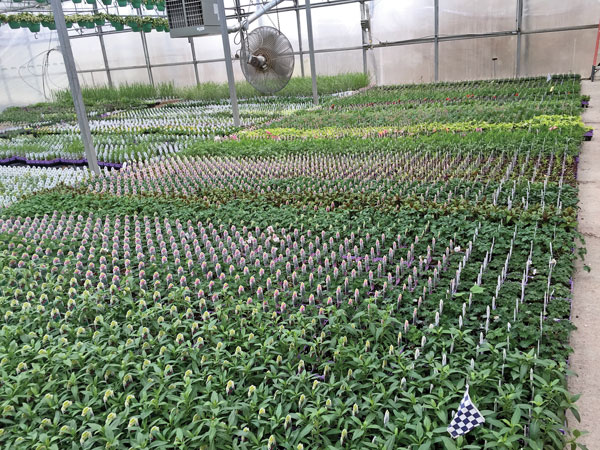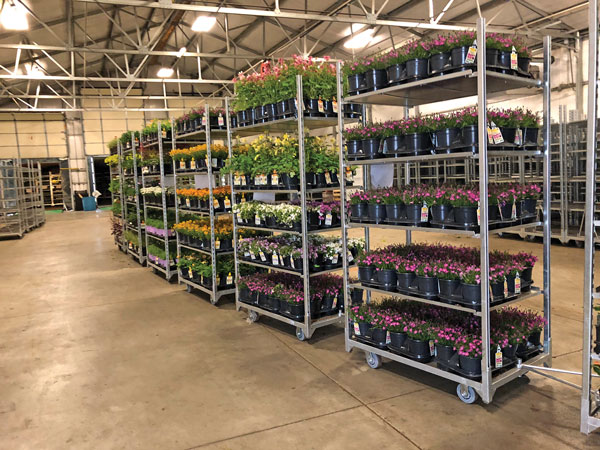6/1/2020
Change is Good
Paul Pilon

As I write this, the world is in the midst of a pandemic and by the time you read this I have no idea if the coronavirus crisis has escalated or become less prevalent. However, I do anticipate the world will be forever changed following this pandemic.
Pictured: Reducing temperatures early in the production cycle will have the greatest effect on plant quality and the ability to hold plants during adverse times, such as we faced this spring.
Due to the unfortunate circumstances we experienced this spring, many growers’ sales were reduced and some growers weren’t even able to open their doors to customers per state executive orders. That was the reality for us here in Michigan; not only were garden centers not allowed to open, but even garden centers at mass merchandisers such as Walmart and Lowe’s weren’t allowed to open and sell plants to consumers. Fortunately, by the last week of April, all garden centers were allowed to open, provided customers wore face masks and practiced social distancing.
With stay-at-home orders in place and reduced sales, many growers needed to grow their perennials significantly differently than they originally planned. Rather than growing plants with both feet on the gas pedal, methods had to be implemented to delay crop development or to hold plants back until their markets opened back up. Keep in mind that in the moment, it was uncertain if the spring season would even happen.
Many growers were pleasantly surprised at how effective these modifications were. In fact, I’ve received comments that they’ll likely modify next year’s practices to obtain some of the benefits they observed this year. What did they observe? Besides delaying crop development until their markets opened up, these growers often observed improved crop quality and a significant energy savings.
In light of the adversity our world is currently facing, we’ve all had to make numerous changes to nearly every aspect of our daily lives. It’s undeniable that not only were many of them necessary, but some of these changes were actually good.
Let’s take a look at several of the changes growers implemented this year to delay crop development or to hold plants in their production facilities. These methods could be useful in future years if you experience a cold, wet spring or they could even become the new, preferred way of growing perennials.
Temperature
Many growers learned firsthand this spring that cool temperatures could be used to not only slow down crop development, but also could be used to improve crop quality, decrease the necessity for PGRs and save money on energy bills. How cool is cool?
If you get into a situation like this year where spring sales are later than anticipated and the crops are near full size, I usually recommend using holding temperatures between 45 and 50F (7 and 10C). Some growers go as low as 42F (5C). Cold-sensitive plants shouldn’t be exposed to temperatures below 50F (10C).
 Pictured: At the end of the day, high-quality crops can be successfully grown using a combination of holding techniques.
Pictured: At the end of the day, high-quality crops can be successfully grown using a combination of holding techniques.
Cool temperatures can also be used nearly the entire crop cycle. I prefer to get them established by providing 60 to 65F (15 to 18C) for the first 10 to 14 days after potting to allow time for them to develop a reasonable root system. Then reduce the temperatures to about 55F (12C) for the remainder of the crop. This approach adds at least seven days (probably 10 days) to the overall production times, so adjust your crop schedules accordingly.
Decreasing production temperatures is the most effective method of slowing growth and for holding plants until they can be sold.
Fertility
When growing perennials cooler, the fertility levels can also be reduced. Essentially, decrease the fertility levels by half. This can be done by delivering half the amount of nitrogen and maintaining the EC of the growing mix in half as well. These levels will provide a good baseline and shouldn’t be low enough for chlorosis to appear. If the plants become slightly off-color, simply provide normal fertilizer levels for an irrigation or two and then go back to the reduced levels. Do not modify the pH; keep them within the original desired ranges.
Ammoniacal sources tend to increase leaf expansion. For this reason, it’s best to use nitrate nitrogen sources during holding periods. Aim for fertilizer containing no more than 10% to 20% ammoniacal nitrogen. High phosphorus levels have been shown to increase stem elongation. During normal production, it’s only necessary to provide between 8 and 12 ppm phosphorus; during holding periods, phosphorus can be cut down to 5 ppm.
PGRs
PGRs can also be used to help growers maintain plant size and for maintaining plant quality while perennials are on hold during unforeseen circumstances like we found ourselves in this spring. Although they can be applied at the end of the crop cycle to hold plants, I typically experience better holding ability when PGRs are used during production rather than just at the end. To accomplish good height control, increased quality attributes and improved holding characteristics, I find it’s best to apply multiple spray applications using low to moderate application rates.
When using PGRs for this purpose, it’s important to remember the goal is to use effective rates to reduce plant growth for two to three weeks without persistent residual. Treated plants still need to perform.
Embracing change
Putting just these three strategies into place during times when your markets are delayed, whether it’s caused by the weather or something bigger like this pandemic, will greatly improve your ability to hold crops longer than you intended. The most benefits will be obtained when these methods are implemented as early as possible. Call it instinct or foresight, but reacting as quickly as possible will result in the most benefits. You may not have a crystal ball, but you do have these strategies to modify your crops’ future. If you’re prepared and embrace it, change can be good. GT
Paul Pilon is a Perennial Production Consultant and editor-at-large of the Perennial Pulse e-newsletter. Feel free to contact him with article topics or to address your perennial production challenges. He can be reached at paul@perennialsolutions.com.